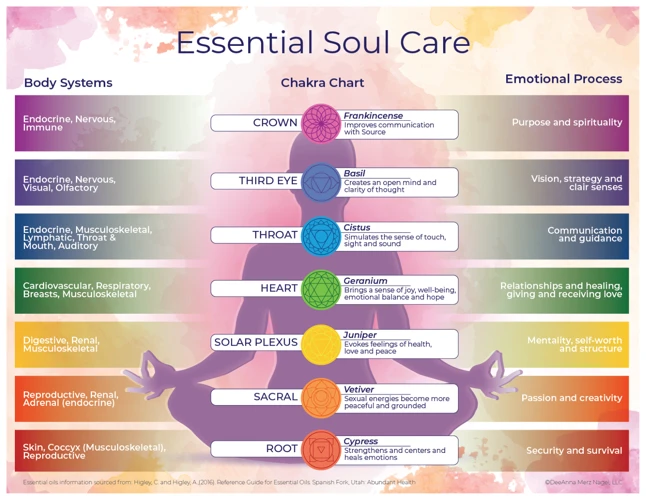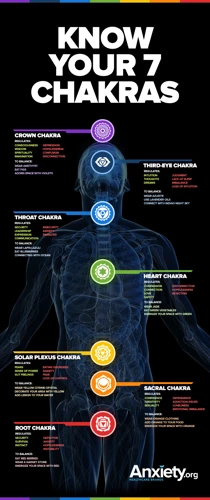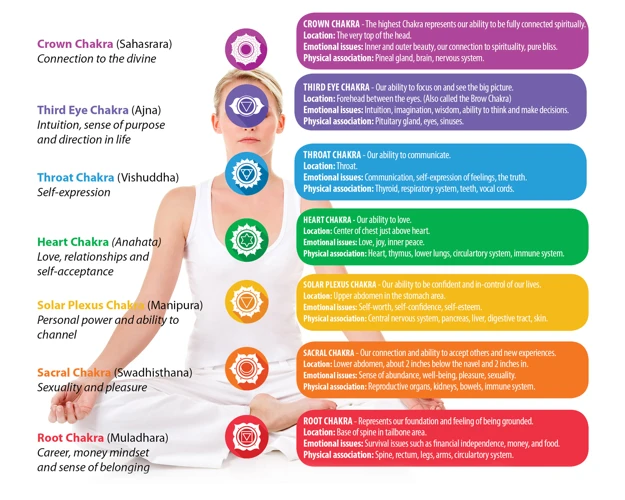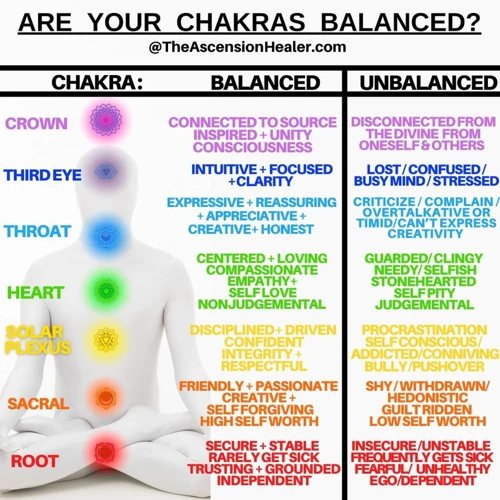Have you ever felt like your emotions are out of control and impacting your daily life? Or maybe you feel like you have emotional blockages that are preventing you from being your best self? It’s possible that your chakras could be unbalanced. Chakras are energy centers in the body that, when balanced, can lead to emotional and physical harmony. Understanding the relationship between chakras and emotional healing can help you find ways to improve your emotional wellbeing. In this guide, we will explore the seven chakras, how they affect emotions, and how to balance them for optimal emotional healing. Get ready to dive deep into the world of chakras and find a path towards emotional balance and wellness.
What are Chakras?

Have you ever heard of the term chakras and wondered what it meant? Chakras are energy centers located throughout the body that are believed to affect our physical, emotional, and spiritual well-being. These energy centers have been studied for centuries in Eastern cultures and are becoming more popular in the Western world as well. Understanding what chakras are and how they work is the first step towards achieving balance and harmony within yourself. Let’s delve deeper into the world of chakras and what they mean for you.
The Seven Chakras
The seven chakras are the energy centers in our body through which the life force or **prana** flows. Each chakra represents a different aspect of our being, from our physical body to our emotional and spiritual selves. Understanding the functions of these chakras can help us understand how they affect our emotions and ultimately our overall well-being.
The chakras are located along the central channel of the body, starting from the base of the spine and extending up to the crown of the head. Here are the seven chakras in detail:
– **Root Chakra:** The root chakra or Muladhara is located at the base of the spine. It is associated with our sense of security, stability, and survival.
– **Sacral Chakra:** The sacral chakra or Svadhisthana is located just below the navel. It is associated with our sexuality, creativity, and ability to experience pleasure.
– **Solar Plexus Chakra:** The solar plexus chakra or Manipura is located above the navel. It is associated with our self-esteem, self-worth, and personal power.
– **Heart Chakra:** The heart chakra or Anahata is located at the center of the chest. It is associated with love, compassion, and forgiveness.
– **Throat Chakra:** The throat chakra or Vishuddha is located at the base of the neck. It is associated with our ability to communicate clearly and express ourselves truthfully.
– **Third Eye Chakra:** The third eye chakra or Ajna is located at the forehead between the eyebrows. It is associated with our intuition, imagination, and ability to see the big picture.
– **Crown Chakra:** The crown chakra or Sahasrara is located at the top of the head. It is associated with our connection to the Divine and our spiritual purpose.
Understanding the functions of each chakra is the first step in balancing them for emotional healing.
How do Chakras Affect Emotions?

The chakras are energy centers within the body that are believed to affect a person’s emotions, physical well-being, and spiritual health. Each chakra is associated with a different aspect of the body, and when one or more of the chakras are blocked, it can cause emotional and physical imbalances.
The chakras function as a complex system that can become unbalanced due to various factors such as stress, trauma, illness, or negative thought patterns. When a chakra is blocked, its corresponding physical and emotional functions can be disrupted.
For example, if the root chakra, located at the base of the spine is blocked, a person may experience feelings of fear, anxiety, or insecurity. The sacral chakra, located in the lower abdomen, relates to creativity and sexuality, so if it is blocked, a person may struggle with low libido, difficulty expressing oneself creatively or feel uninspired.
Similarly, if the heart chakra, located in the center of the chest, is blocked, a person may have trouble with relationships, find it hard to give love, or experience heart problems. While the throat chakra, located at the base of the throat, relates to communication, so blockage may result in feelings of anxiety, difficulty expressing oneself or physical symptoms such as chronic sore throats.
In contrast, when the chakras are balanced and functioning optimally, they work harmoniously and allow energy to flow freely, leading to emotional stability and physical well-being. As a result, a person is able to experience a sense of clarity, passion, and purpose in their life.
Understanding how the chakras affect one’s emotional well-being and physical health is essential to achieving total wellness. By becoming aware of the functions of each chakra and how they affect one’s inner energy system, an individual can take the necessary steps to balance and harmonize their energy centers for better emotional and physical health.
Understanding the Connection Between Chakras and Emotions

As we explore the world of chakras and emotions, it is essential to understand the intricate connection between these two aspects. The human body is a complex system, and the chakras play a crucial role in regulating the flow of energy throughout it. Each chakra is associated with specific emotions, and an imbalance in any of these energy centers can affect our emotional and mental well-being. So, let’s dive deep into the fascinating world of chakras and emotions and explore their intricate connection.
Root Chakra and Grounding
The root chakra, also known as the Muladhara chakra, is the first of the seven chakras and is located at the base of the spine. This chakra is associated with grounding and stability. When this chakra is balanced, we feel secure and grounded in our daily life. However, if it becomes imbalanced, we may feel anxious, fearful, and have a lack of energy.
Characteristics of the Root Chakra:
| Location | Base of the spine |
|---|---|
| Color | Red |
| Element | Earth |
| Associated Body Parts | Feet, Legs, Bones, Rectum |
| Emotional Issues | Survival, Security, Grounding |
To balance the root chakra and promote grounding, there are various techniques you can practice:
1. Meditation: Sit comfortably with your spine straight and feet on the ground. Take deep breaths and imagine roots extending from your tailbone into the earth. Visualize yourself being grounded and stable.
2. Yoga: Poses that focus on the lower body, such as Tree pose, Warrior I and II, and Triangle pose, can help with grounding and stability.
3. Crystals: Red jasper, hematite, and black tourmaline are great for grounding and balancing the root chakra.
4. Aromatherapy: Essential oils such as patchouli, vetiver, and cedarwood can promote grounding and stability.
By practicing these techniques on a regular basis, you can begin to balance your root chakra, feel more grounded in your daily life, and improve your overall emotional wellbeing.
Sacral Chakra and Creativity
The sacral chakra is the second chakra, located in the lower abdomen, and is associated with creativity, sexuality, and pleasure. A balanced sacral chakra allows for the free flow of energy and stimulates creativity, healthy relationships, and pleasure. Imbalance in this chakra can lead to emotional and physical issues.
When the sacral chakra is blocked or underactive, it can lead to a lack of creativity, disinterest in pleasure, and difficulty in maintaining healthy relationships. On the other hand, an overactive sacral chakra can lead to addictive behavior, emotional instability, and obsession with pleasure.
To balance the sacral chakra and enhance creativity, there are several practices that can be implemented:
– Expressive Arts Therapy: This can include drawing, painting, dancing or any other form of creative expression. These activities can help unlock creativity and emotions that may be suppressed.
– Meditation: Focus on the sacral chakra during meditation, picturing a warm orange glow to help release blockages and stimulate creativity.
– Yoga: Specific yoga poses can help balance the sacral chakra. Poses such as Cobra, Pigeon, and Garland are helpful in stimulating the flow of energy to the sacral chakra.
– Aromatherapy: Essential oils such as sandalwood, ylang-ylang, and clary sage can be used to balance the sacral chakra and stimulate creativity.
– Healthy Relationships: Creating and maintaining healthy relationships can help balance the sacral chakra. This involves setting boundaries, expressing emotions effectively, and practicing empathy and compassion.
By incorporating these practices into daily life, one can balance the sacral chakra and enhance creativity, pleasure, and healthy relationships.
Solar Plexus Chakra and Confidence
The solar plexus chakra, also known as the Manipura, is located in the area above the navel and is associated with personal power, self-esteem, and confidence. When this chakra is out of balance, you may experience feelings of low self-worth, a lack of motivation, and fear of rejection.
Symptoms of an Unbalanced Solar Plexus Chakra
| Underactive Solar Plexus Chakra | Overactive Solar Plexus Chakra |
| Low self-esteem | Egoistic behavior |
| Lack of confidence | Aggressive behavior |
| Depression | Controlling behavior |
| Difficulty making decisions | Arrogance |
| Feeling powerless | Perfectionism |
To balance the solar plexus chakra, there are several techniques you can practice. This chakra is associated with the element of fire, so any activities that stimulate this element can be helpful.
Techniques to Balance Your Solar Plexus Chakra
| Techniques | Description |
| Mental Exercises | Practice positive affirmations and visualize a bright, glowing yellow light filling your solar plexus area. |
| Yoga Poses | Poses that focus on the core, such as Navasana (Boat Pose) and Surya Namaskar (Sun Salutation), can help to activate and balance the solar plexus chakra while strengthening the abdominal muscles. |
| Aromatherapy | Scents like lemon and bergamot are associated with the solar plexus chakra and can help to balance the energy in this area. |
| Crystals | Gemstones like citrine, yellow topaz, and yellow sapphire are associated with the solar plexus chakra and can help to balance its energy. |
| Color Therapy | Focus on wearing yellow clothing or surrounding yourself with this color to help balance the solar plexus chakra. |
When the solar plexus chakra is balanced, you will experience a sense of personal power, self-confidence, and motivation. You will be able to make decisions with ease, take risks, and stand up for yourself. Balancing this chakra can help you to achieve success in your personal and professional life.
Heart Chakra and Love
The fourth chakra is known as the Heart Chakra, and as the name suggests, it is associated with love, compassion, and understanding. This chakra is located at the center of the chest, and it also represents our ability to give and receive love.
The Heart Chakra governs our emotional well-being and influences how we connect with others. When this chakra is balanced, we experience love and compassion for ourselves and others. However, when it is blocked or weakened, we may struggle with feelings of jealousy and resentment.
One way to balance the Heart Chakra is through activities that promote self-love and compassion. Practicing yoga poses such as Camel, Upward-Facing Dog, and Fish can help to open this chakra and release any tension or negativity that may be blocking it. Additionally, using essential oils like rose or jasmine can help to stimulate the olfactory system and promote emotional healing.
Here is a table explaining the Heart Chakra in more detail:
| Heart Chakra | Location | Color | Element |
|---|---|---|---|
| Love and Compassion | Center of chest | Green or Pink | Air |
The Heart Chakra represents our ability to give and receive love and compassion. Balancing this chakra is crucial for emotional well-being and connecting with others. Yoga poses, essential oils, and activities that promote self-love can help to balance this chakra and promote overall emotional healing.
Throat Chakra and Communication
The throat chakra is a center of communication, both in terms of expressing oneself and in terms of listening to others. The throat chakra is located at the base of the throat and is associated with the color blue. When the throat chakra is balanced, one is able to communicate effectively and honestly, expressing oneself with clarity and confidence. On the other hand, when the throat chakra is blocked or imbalanced, one may struggle with expressing oneself and may feel anxious or shy in social situations. This can lead to feelings of isolation and loneliness.
One way to balance the throat chakra is through exercises focused on communication. Speaking honestly and openly with others can help to open up the throat chakra and improve communication skills. Another way to balance the throat chakra is through visualization exercises that focus on the color blue. Meditating on the color blue can help to activate and balance the throat chakra.
There are a variety of therapies that can help to balance the throat chakra. For example, aromatherapy using essential oils such as peppermint or eucalyptus can help to stimulate the throat chakra. Wearing blue clothing or jewelry can also help to activate the throat chakra. Crystal therapy is another effective way to balance the throat chakra, with blue stones such as lapis lazuli or aquamarine being particularly beneficial.
The throat chakra plays a crucial role in communication and self-expression. By engaging in exercises and therapies that activate and balance this chakra, one can improve their ability to speak their truth and connect with others authentically.
Third Eye Chakra and Intuition
The Third Eye Chakra, or Ajna Chakra, is located in the center of the forehead and is associated with intuition and wisdom. When this chakra is balanced, it allows for clear thinking, insight, and the ability to see beyond the physical world.
Signs of an Imbalanced Third Eye Chakra:
- Indecisiveness
- Difficulty making decisions
- Lack of imagination and creativity
- Poor memory and inability to concentrate
- Feeling disconnected from oneself and the world around them
When the Third Eye Chakra is overactive, it can lead to an over-reliance on intuition and an inability to see things logically. On the other hand, when it is underactive, it can lead to a lack of imagination and difficulties with decision-making.
How to Balance the Third Eye Chakra:
- Meditation: Taking time to focus on the Third Eye Chakra through meditation can be a powerful tool for balancing it. Visualizing the chakra as a bright indigo color and repeating affirmations such as “I trust my intuition” can be helpful.
- Yoga: Certain yoga postures, such as child’s pose and downward facing dog, can help to activate and balance the Third Eye Chakra.
- Crystals: Crystals such as amethyst and lapis lazuli are said to be particularly helpful for balancing the Third Eye Chakra.
- Aromatherapy: Essential oils such as frankincense and clary sage can help to balance the Third Eye Chakra when used in aromatherapy.
Balancing the Third Eye Chakra allows for better decision-making, clearer thinking and improved creativity. It can also deepen one’s spiritual practice and overall sense of well-being.
Crown Chakra and Spirituality
The Crown Chakra is the seventh chakra and is located at the top of the head. This chakra is associated with spiritual connection and enlightenment. It is often referred to as the “seat of consciousness” and represents the highest level of consciousness and awareness.
Characteristics:
The Crown Chakra is often associated with the following characteristics:
| Characteristic | Description |
|---|---|
| Connection to the divine | The Crown Chakra is responsible for allowing you to connect with the divine and receive guidance from the universe. |
| Awareness | It helps you expand your awareness beyond your physical limits and allows you to connect with your higher self and the collective consciousness. |
| Purpose | The Crown Chakra helps you understand your life’s purpose and gives you clarity on your spiritual journey. |
Imbalanced Crown Chakra:
When the Crown Chakra is imbalanced, it can manifest in the following ways:
- Feeling disconnected from oneself and the universe
- Lack of purpose or direction in life
- Feeling stuck in negative thought patterns and beliefs
- Difficulty accepting and connecting with spirituality
- Feelings of ungroundedness and confusion
How to Balance the Crown Chakra:
There are several ways to balance the Crown Chakra, including:
- Meditation: Practice meditation to calm your mind and connect with your higher self
- Affirmations: Repeat positive affirmations to yourself to help shift negative thought patterns and beliefs
- Yoga: Practice specific yoga poses like Headstand, Lotus Pose, or Tree Pose to stimulate your Crown Chakra
- Purple colored gemstones: Use gemstones like amethyst and clear quartz to increase spiritual awareness and enhance intuition
- Aromatherapy: Use essential oils like lavender and frankincense to enhance spiritual connection and calm the mind
By balancing the Crown Chakra, you can experience a deeper sense of purpose, spiritual connection, and overall mental clarity.
How to Balance Your Chakras for Emotional Healing

Are you feeling out of balance emotionally? Do you want to explore ways to improve your emotional well-being? One method to achieve emotional healing is through balancing your chakras. Balancing your chakras can help reduce stress, anxiety, and promote a feeling of overall well-being. There are various techniques that can be employed to balance your chakras, which we will discuss in this section. So, let’s dive in and learn about different ways to balance your chakras!
Meditation and Visualization
One effective way to balance your chakras for emotional healing is through meditation and visualization. This practice involves focusing your mind on each of the chakras, one at a time, and visualizing each chakra being cleansed and balanced.
Here are some steps you can follow to try this technique:
- Find a quiet and comfortable space: Look for a place where you won’t be disturbed while meditating. Choose a comfortable seat or lie down on a mat or bed.
- Take deep breaths: Inhale deeply through your nose, hold for a few seconds, and then exhale slowly through your mouth. Repeat this several times until you feel relaxed.
- Visualize each chakra: Start with the root chakra and visualize a red spinning wheel at the base of your spine. Imagine the color becoming brighter and the wheel spinning faster with each breath. Move on to the sacral chakra, located just below your navel, and visualize an orange wheel spinning. Continue with the remaining chakras, one by one, in the order they are located in your body.
- Focus on any imbalances: As you visualize each chakra, pay attention to any areas that feel blocked or imbalanced. Visualize any negative energy being released and replaced with positive, healing energy.
- Repeat as needed: You can repeat this meditation for as long as you like, focusing on each chakra and any imbalances you notice.
Meditation and visualization can be powerful tools for balancing your chakras and promoting emotional healing. By visualizing each chakra being cleansed and balanced, you can release negative energy and replace it with positive energy, promoting greater overall balance and wellbeing.
Yoga and Physical Exercise
Physical exercise, particularly through the practice of yoga, is an effective way to balance your chakras and promote emotional healing. The various poses and stretches in yoga can help stimulate and activate each chakra, allowing energy to flow freely throughout the body.
Here are some specific yoga poses and exercises for each chakra:
- Root Chakra: Tree Pose, Mountain Pose, Warrior Pose
- Sacral Chakra: Bound Angle Pose, Cobra Pose, Triangle Pose
- Solar Plexus Chakra: Boat Pose, Warrior III Pose, Plank Pose
- Heart Chakra: Camel Pose, Cat-Cow Pose, Cobra Pose
- Throat Chakra: Fish Pose, Shoulderstand, Supported Headstand
- Third Eye Chakra: Child’s Pose, Downward Dog, Seated Forward Bend
- Crown Chakra: Lotus Pose, Meditation Pose, Corpse Pose
These poses help stretch and strengthen the muscles associated with each chakra, promoting balance and energy flow. Additionally, incorporating other physical exercises into your routine, such as jogging or weightlifting, can also have a positive effect on your chakras.
Combining physical exercise with focused breathing techniques can further enhance the benefits of yoga and promote emotional healing. By focusing on the breath, you can calm the mind and allow negative emotions to pass.
It’s important to note that physical exercise alone may not fully balance your chakras. It’s best to incorporate a variety of methods, such as meditation, crystal therapy and color therapy, to achieve the most effective and long-lasting results.
Crystal and Aromatherapy
One powerful way to balance your chakras is through the use of crystals and aromatherapy. Crystals are believed to have unique healing properties that can help align chakras and release emotional blockages. Each type of crystal is associated with a particular chakra, and can be placed on the corresponding area of the body during meditation or used in jewelry or decor.
Here are some examples of crystals and their associated chakras:
- Root Chakra: Red Jasper, Black Tourmaline, Hematite
- Sacral Chakra: Carnelian, Moonstone, Orange Calcite
- Solar Plexus Chakra: Citrine, Tiger’s Eye, Yellow Jasper
- Heart Chakra: Rose Quartz, Green Aventurine, Rhodochrosite
- Throat Chakra: Aquamarine, Blue Lace Agate, Lapis Lazuli
- Third Eye Chakra: Amethyst, Fluorite, Labradorite
- Crown Chakra: Clear Quartz, Amethyst, Selenite
Aromatherapy involves the use of essential oils to create a desired mood or effect. This practice can also be used to balance chakras by selecting oils that correspond to each energy center. Some popular essential oils for each chakra include:
- Root Chakra: Patchouli, Cedarwood, Frankincense
- Sacral Chakra: Ylang Ylang, Orange, Sandalwood
- Solar Plexus Chakra: Peppermint, Lemon, Ginger
- Heart Chakra: Rose, Bergamot, Lavender
- Throat Chakra: Peppermint, Eucalyptus, Chamomile
- Third Eye Chakra: Lavender, Frankincense, Clary Sage
- Crown Chakra: Sandalwood, Myrrh, Lotus
Using these natural remedies can help to promote balance and healing in your chakras, leading to a greater sense of emotional well-being.
Color Therapy
In addition to meditation, yoga, and aromatherapy, color therapy can also be used to balance the chakras for emotional healing. Each chakra is associated with a specific color, so incorporating those colors into your environment, clothing, or even food can help activate and balance the corresponding chakra.
Here are the corresponding colors and their associated chakras:
- Red: Root Chakra
- Orange: Sacral Chakra
- Yellow: Solar Plexus Chakra
- Green or Pink: Heart Chakra
- Blue: Throat Chakra
- Purple: Third Eye Chakra
- White or Violet: Crown Chakra
You can incorporate these colors into your life in various ways. For instance, if you’re struggling with confidence or self-esteem issues related to your solar plexus chakra, wearing yellow clothing, decorating your workspace with yellow flowers, or eating yellow fruits and vegetables like bananas, squash, or lemon can help stimulate the chakra.
Using visualization techniques can also be helpful in color therapy. During meditation, visualize a bright ball of the corresponding color swirling in the location of the chakra. This can help boost the energy flow around that area.
Color therapy is a simple yet effective method to balance the chakras for emotional healing. Incorporating the colors into your surroundings and daily life can create a harmonious environment and promote overall well-being.
Benefits of Balanced Chakras
Balancing your chakras can have a multitude of benefits for your overall health and well-being. When your chakras are balanced, energy can flow freely through your body, leading to a sense of harmony and balance. Here are some of the benefits of having balanced chakras:
Improved emotional well-being: Balanced chakras can help you feel more in control of your emotions, leading to a greater sense of inner peace and calm. You may also experience less anxiety, depression, and other negative emotions.
Increased physical health: When your chakras are balanced, your physical body can also benefit. You may experience improved digestion, better sleep, less chronic pain, and a stronger immune system.
Heightened spiritual awareness: Your chakras are responsible for regulating the flow of energy throughout your body, including the flow of spiritual energy. Balanced chakras can lead to a greater sense of spiritual awareness, allowing you to connect more deeply with yourself and the world around you.
Greater creativity and inspiration: When your sacral chakra is balanced, you may experience a greater sense of creativity and inspiration. This can help you in your artistic pursuits, as well as in your problem-solving abilities.
Improved communication: A balanced throat chakra can help you communicate more effectively, both with others and with yourself. You may find that you are more confident in expressing your thoughts and ideas, and that you are a better listener as well.
Increased intuition: When your third eye chakra is balanced, you may experience greater intuition and psychic abilities. This can help you make better decisions, both in your personal and professional life.
Having balanced chakras can lead to a greater sense of well-being and connection with yourself and the world around you. By incorporating chakra-balancing practices into your daily routine, you can experience these benefits for yourself.
Conclusion
In conclusion, the relationship between chakras and emotional healing is a complex and intricate topic that requires a deep understanding of both the physical and metaphysical aspects of our being. From the root chakra to the crown chakra, each chakra plays a critical role in our emotional well-being and can have a profound impact on our overall health and happiness.
By learning about the seven chakras and the role they play in regulating our emotions, we can begin to take steps towards healing and balancing our energy centers. Through practices such as meditation, yoga, and aromatherapy, we can work to restore balance and harmony to our chakras, promoting emotional healing and a sense of inner peace.
While it may take time and dedication to fully balance and heal our chakras, the benefits are well worth the effort. A balanced chakra system can lead to improved physical health, emotional stability, and spiritual growth.
Thus, by taking the time to understand and work with our chakras, we can open ourselves up to a world of positive energy, emotional healing, and personal growth, unlocking our full potential and living our best lives.
Frequently Asked Questions
What are the signs of an imbalanced chakra?
The signs of an imbalanced chakra may include physical, emotional, or mental symptoms such as anxiety, depression, physical pain, and fatigue.
Can chakras affect physical health?
Yes, imbalanced chakras can affect physical health by causing a range of physical symptoms such as headaches, digestive issues, and chronic pain.
What is the best way to balance chakras?
The best way to balance chakras is through a variety of techniques such as meditation, yoga, and other holistic practices that can help promote energy flow and balance in the body.
Can crystals really help balance chakras?
Yes, crystals can help balance chakras by promoting the flow of energy through the body and providing healing and balance to each energy center.
What role does color therapy play in chakra balancing?
Color therapy can be a powerful tool for balancing chakras by using different colors to activate and balance each energy center in the body.
Is it possible to have too much energy in a chakra?
Yes, an overactive chakra can lead to an excess of energy in that specific energy center. This can cause a range of physical and emotional symptoms associated with imbalanced chakras.
Can yoga help balance chakras?
Yes, yoga can be an effective way to balance chakras by using specific poses and movements to stimulate and activate each energy center in the body.
What is the relationship between chakras and emotions?
Chakras can have a powerful impact on emotions by influencing our thoughts, feelings, and behaviors. When our chakras are balanced and aligned, we experience positive emotions and greater overall wellbeing.
Can chakra balancing help with anxiety and depression?
Yes, chakra balancing can be a helpful tool for managing anxiety and depression by promoting a greater sense of balance and wellbeing in the body.
How often should you balance your chakras?
The frequency of chakra balancing will depend on the individual and their specific needs. However, regular practice of chakra balancing techniques can help promote long-term health and wellbeing.








